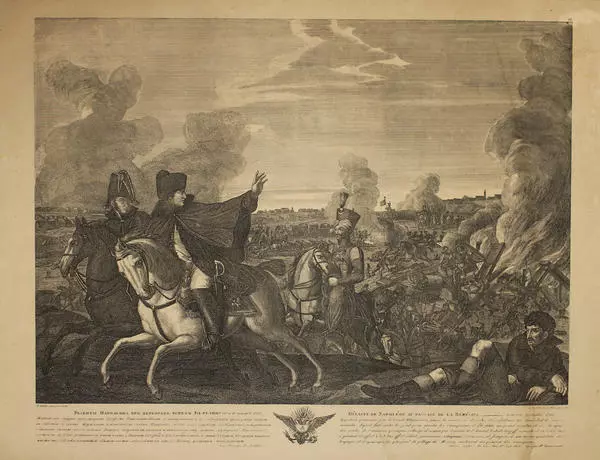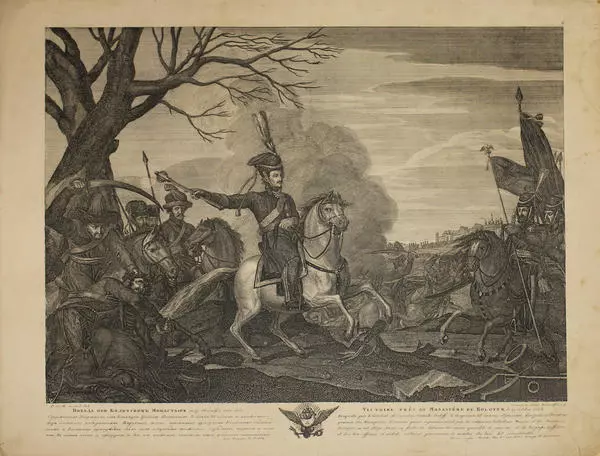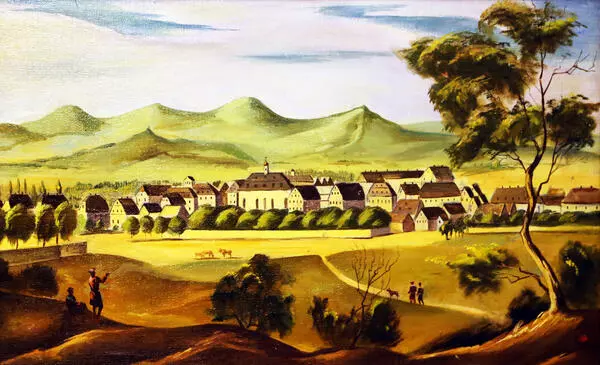The painting by Sergei Fyodorov shows the German colony of Sarepta, depicted from the side of the Ergeni Upland. The painting is based on an old engraving by an unknown artist of the late 18th - early 19th centuries.
Sarepta was the first and only Russian colony of the Fraternal Union of Hernguters - Moravian brothers, representatives of Protestantism. Sarepta developed rapidly economically and culturally due self-financing targeting and being granted with significant privileges from Russian monarchs.
By the beginning of the 19th century, the village had become one of the largest commercial, industrial and cultural centers of the Lower Volga region. The Sareptians made a significant contribution to the development of the economy of the Lower Volga region, to the overall growth and development of the light, processing and food industries in Russia.
Some agricultural crops, such as mustard, potatoes, tobacco were grown in Sarepta for the first time in the region. Sarepta balsam, mustard powder and oil have become known not only in Russia, but also abroad.
The educational institutions in the colony were considered the best in the region, and the level of education and upbringing of young people was high. The colonial scientists achieved major successes in the field of medicine, chemistry, physics, industrial production technology, and the development of new varieties of cultivated plants. There were historians, archaeologists, ethnographers, linguists, zoologists, ornithologists, entomologists and botanists among the Sareptians.
For many years the Sarepta mineral water resort has been a place of rest and treatment for the Russian aristocracy. In addition, many prominent scientists, writers and travelers from Russia and abroad have visited the colony for scientific and educational purposes.
The Ergeni Upland where Sarepta was located is a plateau-like elevation close to triangular in shape in the southeast of the European part of Russia, about 300 kilometers long and 50 kilometers wide in the northern part and up to 350 kilometers in the southern part.
The northern outskirts of Ergeni are located within the modern Volgograd region, most of the western slope is in the Rostov region, the eastern slope is in the Republic of Kalmykia. The height of ErgenI ranges from 120-160 meters in the north to 220 meters in the south.
Sarepta was the first and only Russian colony of the Fraternal Union of Hernguters - Moravian brothers, representatives of Protestantism. Sarepta developed rapidly economically and culturally due self-financing targeting and being granted with significant privileges from Russian monarchs.
By the beginning of the 19th century, the village had become one of the largest commercial, industrial and cultural centers of the Lower Volga region. The Sareptians made a significant contribution to the development of the economy of the Lower Volga region, to the overall growth and development of the light, processing and food industries in Russia.
Some agricultural crops, such as mustard, potatoes, tobacco were grown in Sarepta for the first time in the region. Sarepta balsam, mustard powder and oil have become known not only in Russia, but also abroad.
The educational institutions in the colony were considered the best in the region, and the level of education and upbringing of young people was high. The colonial scientists achieved major successes in the field of medicine, chemistry, physics, industrial production technology, and the development of new varieties of cultivated plants. There were historians, archaeologists, ethnographers, linguists, zoologists, ornithologists, entomologists and botanists among the Sareptians.
For many years the Sarepta mineral water resort has been a place of rest and treatment for the Russian aristocracy. In addition, many prominent scientists, writers and travelers from Russia and abroad have visited the colony for scientific and educational purposes.
The Ergeni Upland where Sarepta was located is a plateau-like elevation close to triangular in shape in the southeast of the European part of Russia, about 300 kilometers long and 50 kilometers wide in the northern part and up to 350 kilometers in the southern part.
The northern outskirts of Ergeni are located within the modern Volgograd region, most of the western slope is in the Rostov region, the eastern slope is in the Republic of Kalmykia. The height of ErgenI ranges from 120-160 meters in the north to 220 meters in the south.






